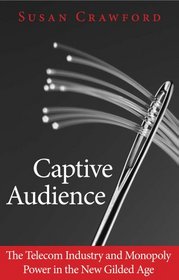Leo T. reviewed Captive Audience: The Telecom Industry and Monopoly Power in the New Gilded Age on + 1775 more book reviews
The author is a troublemaker who has dogged the big businessmen of the telecom industry for years. Deregulation of Ma Bell in 1984 has been followed by reconstituted near monopolies for Internet, cable, programming, etc. in the Information Age.
Excellent introduction that begins with a Senate sub-committee hearing in 2010 on the Comcast-NBC Universal merger; butter would not melt in the mouths of the businessmen testifying. The programming obtained by Comcast in this merger likely makes it impossible for a competitor in the supply of access service to the public to arise, given the control of programming. The following chapters explain how the United States wound up with a rather slow and inexpensive Internet system, that does not allow equally efficient uploads and downloads.
Introduction: pp. 1-34. The author opens with a 2010 Senate subcommittee hearing on Comcast/NBC Universal merger; the CEOs are making nice. Note the utility of equally fast uploads and downloads. The programming obtained by Comcast in the merger likely will make it impossible for a competitor in the supply of service access to prosper and those needing a conduit to customers will have to meet Comcast's terms.
Electricity was a cutting edge business a century ago, but a limited number of Americans have access to it then, many couldn't afford it, and the country handed over control to a limited number of companies. Crawford finds parallels between the Communication firms of today and the oil monopolies of the 19th C.
Chapter One: From RR to Telephone. Through the 1860s, railroads had obtained half of their capital from state and local governments, but there was no regulation, audits, etc (I think of the Credit Mobilier scandal). The Pacific RR Act of 1862 were because the federal government had to go to the corporations as there was no federal civil service capable of building a transcontinental RR (but I recall there was the Erie Canal). RR lawyers (as many as 40,000 strong) were among our first lobbyists (22), The ICC Act of 1887 was passed in response to the Supreme Ct. decision banning regulation of interstate commerce (Wabash cases).
In setting the stage of consideration of telecom regulation today, the author discovered the efforts of the ICC, TR, Taft, etc. and J.P. Morgan's interest in a stable, efficient mode of business (panics were coming every few years).
This book could be employed in a US History or Econ high school classroom that emphasizes reading. Lesson Plan might be to have interested group of students read (10pts) and discuss (10pts) the Intro & Chapter One pp. 1-34. If there is a group still interested, each student could choose a later chapter of interest to read and share (10pts) with the group.
Given the 2016 proposal by AT&T for another big merger, today's LA Times showing the CEOs involved testifying before Congress (butter won't melt in their mouths), this book remains current.
Footnotes, bibliography, index.
Excellent introduction that begins with a Senate sub-committee hearing in 2010 on the Comcast-NBC Universal merger; butter would not melt in the mouths of the businessmen testifying. The programming obtained by Comcast in this merger likely makes it impossible for a competitor in the supply of access service to the public to arise, given the control of programming. The following chapters explain how the United States wound up with a rather slow and inexpensive Internet system, that does not allow equally efficient uploads and downloads.
Introduction: pp. 1-34. The author opens with a 2010 Senate subcommittee hearing on Comcast/NBC Universal merger; the CEOs are making nice. Note the utility of equally fast uploads and downloads. The programming obtained by Comcast in the merger likely will make it impossible for a competitor in the supply of service access to prosper and those needing a conduit to customers will have to meet Comcast's terms.
Electricity was a cutting edge business a century ago, but a limited number of Americans have access to it then, many couldn't afford it, and the country handed over control to a limited number of companies. Crawford finds parallels between the Communication firms of today and the oil monopolies of the 19th C.
Chapter One: From RR to Telephone. Through the 1860s, railroads had obtained half of their capital from state and local governments, but there was no regulation, audits, etc (I think of the Credit Mobilier scandal). The Pacific RR Act of 1862 were because the federal government had to go to the corporations as there was no federal civil service capable of building a transcontinental RR (but I recall there was the Erie Canal). RR lawyers (as many as 40,000 strong) were among our first lobbyists (22), The ICC Act of 1887 was passed in response to the Supreme Ct. decision banning regulation of interstate commerce (Wabash cases).
In setting the stage of consideration of telecom regulation today, the author discovered the efforts of the ICC, TR, Taft, etc. and J.P. Morgan's interest in a stable, efficient mode of business (panics were coming every few years).
This book could be employed in a US History or Econ high school classroom that emphasizes reading. Lesson Plan might be to have interested group of students read (10pts) and discuss (10pts) the Intro & Chapter One pp. 1-34. If there is a group still interested, each student could choose a later chapter of interest to read and share (10pts) with the group.
Given the 2016 proposal by AT&T for another big merger, today's LA Times showing the CEOs involved testifying before Congress (butter won't melt in their mouths), this book remains current.
Footnotes, bibliography, index.




